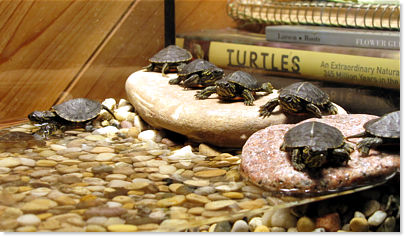
Baby Turtle Blog - The story of a rescued Painted Turtle nest
| By Doug Collicutt |
Sometimes, just when you're feeling the lowest something can happen to snap you out of it. For me a long spell of frustration and lack of interest in everything was snapped when I checked the pail full of sand atop my freezer one night and found a tiny, newly-hatched Painted Turtle. I had been getting ready to chuck out the contents of the pail, having all but given up on successfully hatching out anything from this rescued clutch of eggs. But it made my day to dig around in the pail and come up with ten little baby Painted Turtles!
 The little guys in their temporary home.
The little guys in their temporary home.This was the middle of October, by the way. My son, who'd been working as an interpreter at Manitoba's Grand Beach Provincial Park, located on the east side of Lake Winnipeg, had been given some turtle eggs by some other park workers. They had accidentally dug them up in July while doing some maintenance work. The location wasn't a great spot to rebury them, a parking lot (mother turtles don't always make the best choices for nesting sites), so they had collected the eggs and turned them over to my son thinking he'd know what to do with them. And he did, he called his dad, me, for advice. I've always had a great passion for turtles and had reared eggs and hatchlings before. It was only a couple of years ago when I helped rescue a clutch of Snapping Turtle eggs from a trail at a condo development along Winnipeg's Red River.
|
Now, I'm always concerned when I hear of people digging up turtle nests, accidentally or intentionally, then trying to rebury them elsewhere or keep them in a pail (even though that's what we did). Turtle eggs can be damaged by being moved or even rotated from the position in which they were laid. So I worry that well-intentioned nest "rescuers" may end up causing a clutch of eggs to fail. It's always best to leave turtle nests alone and let nature take its course. Mind you, the usual fate of most turtle nests is to be dug up and the eggs eaten by raccoons, skunks, foxes or other hungry predators.
However, as the fates would have it, my family ended up being entrusted with a pail full of turtle eggs. I figured, "what the heck, let's see what happens", so I set the pail on top of our upright freezer, where it would be warmed by the heat given off. (I use this location to increase germination of seeds, too.) Every couple of days I'd add a bit of water to keep the sand moist. By the time mid-September had rolled around though, I was getting concerned that we wouldn't see any turtles.
|
Turtle Soup! Watch this video to learn about
how baby Painted Turtles protect themselves.
Then in mid-October, as I mentioned above, a random check of the pail revealed a tiny turtle sitting atop the sand and nine more still buried. Five eggs remained, but they never hatched. As it was mid-October I made the decision that it was too late to release the babies into the wild, so the only other option was to rear them over winter then release them the following spring. And, thinking that people might be interested in the process, I decided to start up this baby turtle blog. I hope to make regular updates on the progress of the little guys, maybe once every week or two, until they are released next year.
|
Oh, and by the way, no, I'm not naming them Leonardo, Raphael, Donatello and Michelangelo. I'm long past the age where I felt it necessary to name pets, and anyway these baby turtles aren't pets. They're just temporary lodgers in my basement. (Unlike the permanent cellar-dwellers my sons have become!) Besides, there's ten of them now, it would have to be Leonardo 2, Raphael 2, Donatello 2 and Michelangelo 2, etc. to stay with the Teenage Mutant Ninja theme. So flip to the next page and see how the little guys are doing.
Carry on for Baby Turtle Blog Updates![]()
| You can help NatureNorth produce more great articles with a secure donation through PayPal. Our Google Adsense ads pay our server costs, but that's about it. To learn more follow this link: Support NatureNorth. Thank-you! | |
Return to: Winter Issue | NatureNorth Front page
